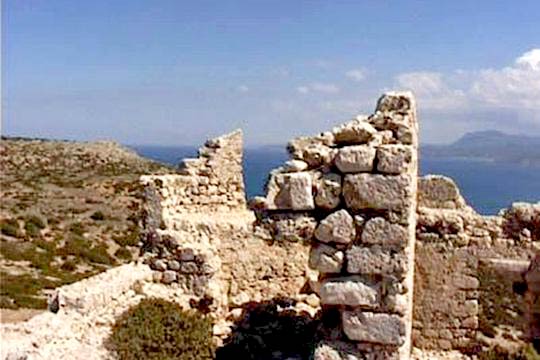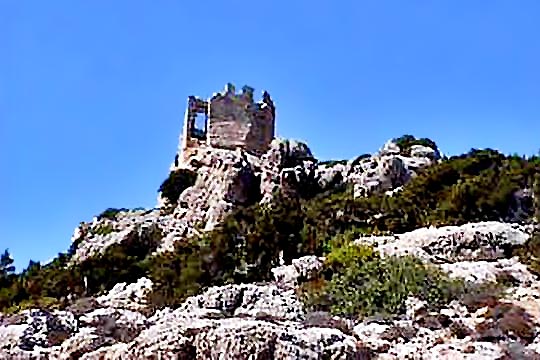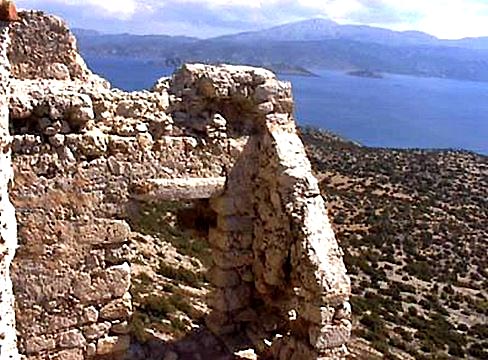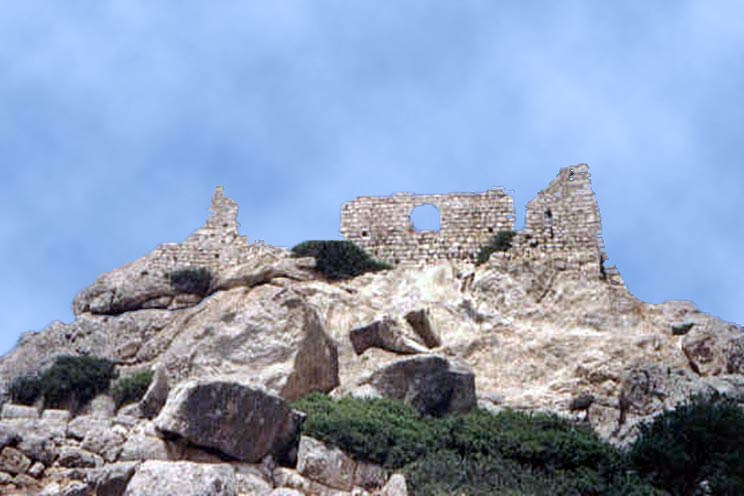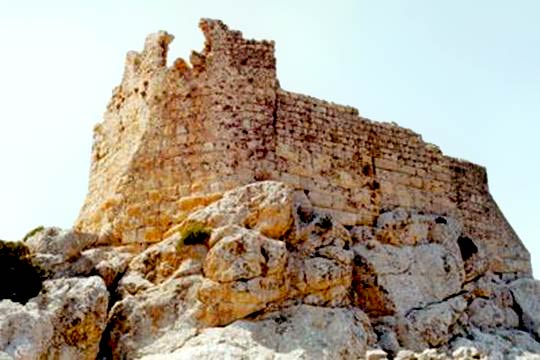Alimia, Chalki, Dodecanese,South Aegean
Castle of Alimia
| Location: |
| On a hill of the Island Alimia, between Rhodes and Chalki, Dodecanese |
| Region > Prefecture: | 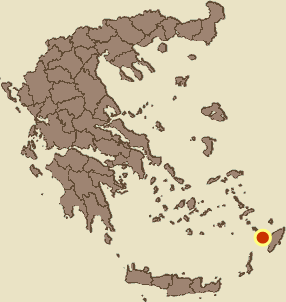 |
| South Aegean Dodecanese | |
| Municipality > Town: | |
| City of Chalki • Alimia | |
| Altitude: | |
| Elevation ≈ 170 m |
| Time of Construction | Origin | |
| 1475 | IOANNITE |
|
| Castle Type | Condition | |
| Castle |
Rather Poor
|
Ancient fortification, first converted into a late-medieval Knights Hospitallers’ watchtower, later extended to a castle by the Knights.
Castle Description
Text: Dr. Michael Losse – Singen (Hohentwiel), Germany (09.08.2021)General Description
Alimia or Alimnia is a Greek island of the Aegean Sea, between Rhodes and Halki, in Dodecanese. The surface of the island is 7.4 square kilometers and has a coastline of 21 km. The island had a small population until the period of the WW II, but now is uninhabited.
There are two large bays in the island which are good natural harbors. During the Hellenistic period, Alimia was the naval station of the navy of Rhodes. In that period, the castle was built on a steep rocky hill with the obvious objective to control the traffic in the seas west of Rhodes and to protect the fleet (Manolis Papathanassiou).
The castle was built in the ruins of an ancient fortification (most probably 4th century BC), of which it is not known whether it was a fort (ochyro) or a "private" castle (Pýrgos). It is smaller than the ancient predecessor building.
The castle is surrounded by ancient wall remains and worked stones, on its south side triangular stones can be found. On the mountainside below the castle, whose location is a rocky peak on the edge of a plateau, there is a lot of collapse, especially large ancient cuboids. In between there are large quantities of ceramics.
In the eastern part of the ancient building complex stands the small castle of the Knights of St. John on the narrow limestone top. The eastern front of the castle was largely made of stones from ancient construction, which belonged to isodomous walls, and the northern front of the castle contains large parts of Hellenistic walls. In part, the enceinte, which supported a battlement with battlements, is slightly embanked.
Inside the castle stands the ruins of a residential building, in the basement of which there was apparently a barrel-vaulted cistern.
Access
Alimiá can be visited by excursion boats from the neighboring island of Chálki. The boats dock in the large bay below the castle, so that the castle can be visited during the bathing break of the other excursionists. No real path. Beware of the snakes!
History of the castle
Knowledge about the older history of Alimiá is largely lacking, but the island is likely to have essentially shared the fate of the neighboring island of Chálki and was mostly administered from there or from Rhódos.
Probably in 1312, Alimiá, together with the neighboring islands, became part of the Knights Hospitallers‘ monastic state, which existed since 1307. In 1366 Borrello Assanti of Ischia, a borghese (= citizen) of Rhodes, received the islands of Hálki and Tílos “in feudo”, as fiefs (cf. the Order‘s chronicler Giacomo Bosio: Dell'Istoria della Sacra Religione et Illustrissima Militia di San Giovanni Gierosolomitano. 3 volumes. Edition of 1695, II, p. 105, cited after Spiteri 1994, p. 164).
Among the conditions of the fief was the construction of a tower on Alimiá (“edificare una Torre nell'Isola di Limonia”), which should be “gagliarda, e forte” and “conformo al disegno, che dato gli sarebbe da due Cavalieri” (ibid.).
Borello Assanti also had to provide three guards for the tower, while the Order wanted to equip another three soldiers as guards (cf. Anthony Luttrell: The Military and Naval Organisation of the Hospitallers at Rhodes, XIX, p. 137).
Whether the construction of the tower was realized in 1366 or shortly thereafter or whether the tower construction, which the Council of the Order decided in Rhódos in 1475, was the first building on this site, remains unclear for the time being. Spiteri (1994, p. 164) suspects that the building decision of 1475 implies that no tower had been built before. In any case, the building was listed in 1476 (Bosio 1695 II, p. 360).
The Kástro of Alimiá is identical to the “tower” of 1476 mentioned in the written sources. Our inspections revealed that the existing building is the extension (1476) of a previously existing medieval tower; joints in the walls suggest this.
Parts of the building material were brought to the island by ship in 1476: “fu mandato una gran Nave Genovese caricata di tutti gli apparechi necessarji, per fabricar la torre all'Isola di Limonia” (Bosio 1695 II, p. 360). The name Torre (tower) for the building built at that time is misleading, since the Kástro of Alimiá is rather a small castle.
Bosio (1695 II, p. 391) also refers to it as “Castello di Limonia”; Spiteri (1994, p. 360) calls it “rather a small fort”.
The small castle of Alimiá was not designed to withstand sieges. Their crew consisted of only six men. As early as 1479, when a major Turkish attack on Rhodes was committed, the castle was abandoned (temporarily?), Bosio (1695 II, p. 391) reports: “l'Castello di Limonia haveva gran mancamento d'Aqua; e che per questo difendere non si poteva; ordino che s'abbandonasse, e che gli Habitatori di quello, ad altri luoghi forti passar.”
The task of the castle was that of an observation post within the Vígla and Watchtower system of the Knights Order's state.
Other Info
SourcesLosse, Michael: Die Kreuzritter von Rhodos – Bevor die Johanniter Malteser wurden. Ostfildern 2011.
Losse, Michael: Die Burgen und Festungen des Johanniter-Ritterordens auf Rhódos und in der Ägäis (Griechenland) 1307-1522. (Publisher: Nünnerich-Asmus Verlag) Mainz 2017.
Spiteri, Stephen C.: Fortresses of the Cross. Hospitaller Military Architecture (1136-1798). Valleta (Malta) 1994.
| First entry in Kastrologos: | March 2013 | Last update of info and text: | October 2021 | Last addition of photo/video: | October 2021 |
Sources
- Photos (1, 2 – May 2011) and article by Dr. Michael Losse
|
|
| Access |
|---|
| Approach to the monument: |
| Take a boat to Alimia. And then take a hike to the castle (about 1 hour) |
| Entrance: |
| Like most remote, ruined and neglected fortifications, entrance is not an issue. The difficult part is to approach the castle and walk around inside. |



